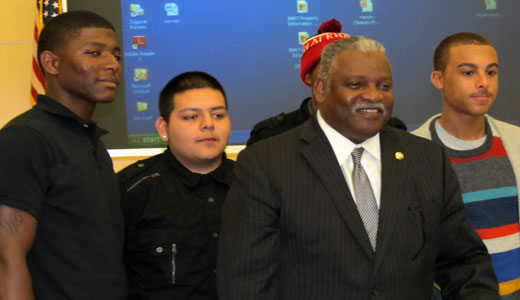
It’s long been known that California’s boys and young men of color – Black, Latino, Asian Pacific Islander, and Native American – suffer disproportionately high rates of poverty, unemployment, discipline, and dropouts from school, poor health outcomes, and high incarceration rates.
Now a state Assembly committee has put together a comprehensive picture of the challenges faced by these young people, along with far-reaching policy and legislative recommendations to start changing the situation.
The state Assembly’s Select Committee on the Status of Boys and Men of Color was chaired by Assemblyman Sandré Swanson, D-Alameda. For a year, it held hearings around the state, from coastal Oakland and Los Angeles to the Central Valley communities of Fresno and Coachella Valley, and the capital, Sacramento. On Aug. 8 it unveiled its findings.
Among them:
- Poverty affects 27 percent of California’s African American and Latino children.
- By the 4th grade, 58 percent of black and 61 percent of Latino students in the state score “below proficient” on a national reading test – more than double the rate for non-Hispanic white students.
- Almost half of California’s young Black and Latino men fail to graduate from high school.
- Youth of color in California suffer disproportionately from diseases and unhealthy conditions in their communities, among them high rates of obesity, childhood-onset diabetes, asthma, and infectious diseases as well as neighborhood violence and high murder rates.
- In California, African American and Latino men ages 15 to 24 were jobless and were incarcerated at rates far above their share in the general population.
Speaking on public radio station KQED Aug. 10, Swanson said that with young people of color making up 71 percent of the state’s population 25 years and younger, California’s future depends on “how we rescue this generation from these problems.”
Swanson said the committee found “tremendous interest in addressing the problem, both by those who find themselves in the middle of trouble, and those who are trying to assist the people who find themselves in the middle of trouble.”
Swanson also pointed out that addressing problems such as growing prison populations and increased recidivism rates could help the state address its dire budget crisis.
Rigo Fuentes, a 16-year-old high school student from Coachella Valley, told KQED, “When the majority of people are suffering, that means the system is wrong. When the system is wrong, that means it is going to start affecting other people. The more people it affects, the less our country grows.”
Among some 65 legislative and policy recommendations:
- Encouraging the hiring of young men of color with “multiple barriers to employment,” including banning “the box” that requires job seekers to state a criminal record on an initial application.
- Funding schools on the basis of regional costs and student needs. Supporting efforts by schools in high poverty areas to hire experienced, effective teachers. Tutoring students who may fail the high school exit exam.
- Increasing state and local job training opportunities. Linking college prep and technical training programs instead of separating them.
- Strengthening publicly funded health care programs for youth of color, including undocumented youth. Extending coverage for foster youths up to age 26.
- Reducing suspensions and expulsions for non-serious discipline problems at school.
- Increasing the number of “full service community schools” and related neighborhood programs providing health, mental health, educational support services and support for students and families.
- Coordinating the work of agencies serving the same person.
The draft recommendations will be open for comment for 30 days. The Select Committee will then vote on the final report and send it to the legislature. Swanson, who is termed out of office after the current session, recommends the committee be continued under new leadership.
Select Committee members have introduced 19 bills based on the recommendations. Swanson said he expected 14 to reach Governor Jerry Brown’s desk for signature.
Photo: Assemblyman Sandre Swanson, with young participants in Oakland. PW












Comments